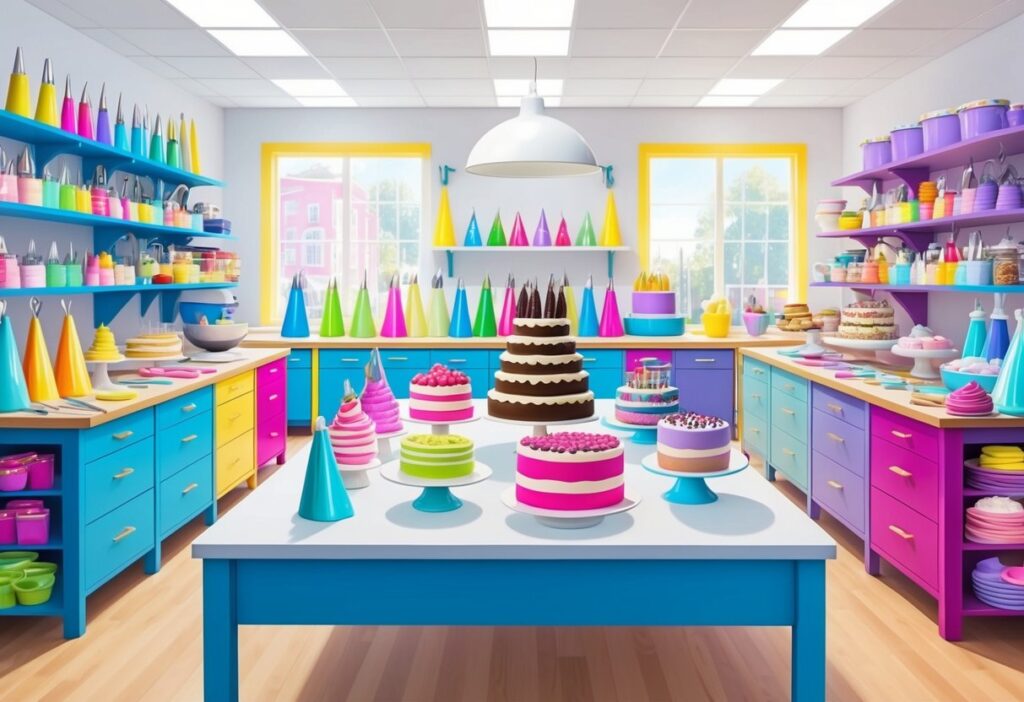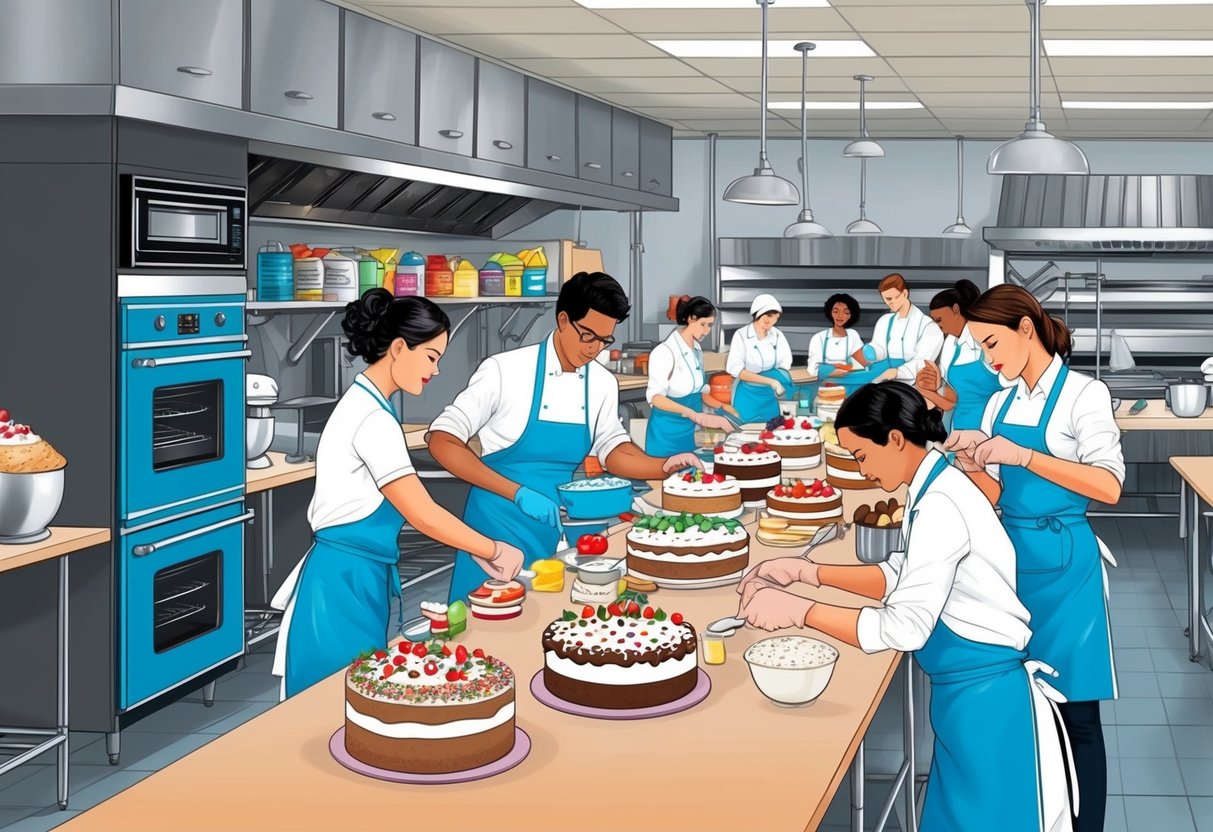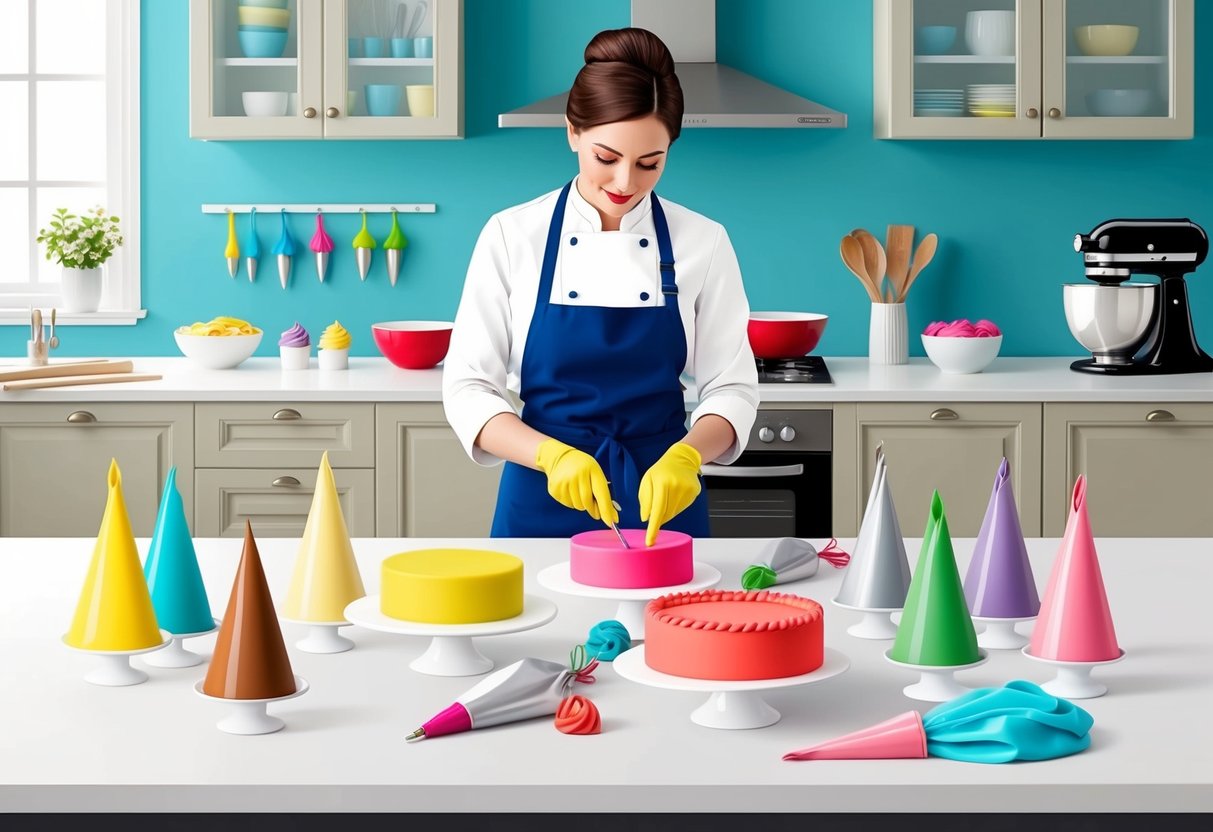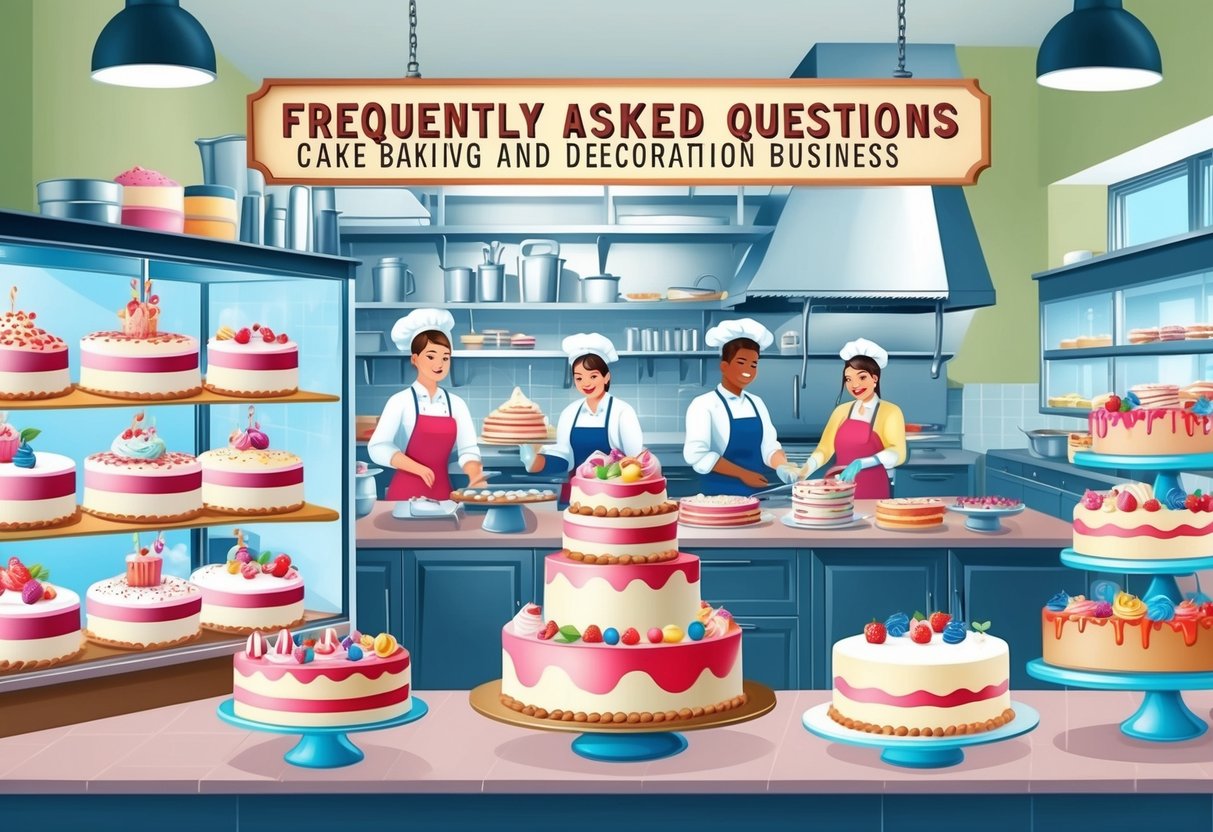Starting Your Cake Baking and Decoration Business
Starting a cake baking business requires careful planning, understanding of legal requirements, and clear business strategies. A successful bakery business combines both creative skills and business acumen. If you search the internet you will many posts asking how to start a cake making business, and the truth is there just aren’t many good answers out there. So we decided to take our own experience and reach out to more than a dozen successful cake business owners to create this comprehensive cake business blueprint for you.
Table of Contents
Understanding the Basics of a Baking Business
A cake decorating business involves more than just baking skills. You need to understand your target market, competition, and unique selling proposition.
Start by researching local bakeries to identify gaps in the market. Practice your recipes and techniques before launching.
Perfect your signature items and ensure consistent quality. Many successful bakers recommend starting with a small menu of items you excel at rather than offering too many options.
Track all expenses from the beginning. Ingredients will be your largest cost, but don’t forget packaging, disposables (like piping bags and gloves), and decorative elements. Create a detailed cost sheet for each product.
Set clear pricing that covers all costs plus profit. Many new bakers undercharge, leading to burnout. Calculate ingredients, labor, overhead, and packaging before setting prices.
Developing a Business Plan for Your Cake Bakery
A solid business plan serves as your roadmap. Include market analysis, financial projections, marketing strategies, and growth plans. This document isn’t just for loans—it clarifies your business vision.
Key Business Plan Components:
- Executive summary
- Company description
- Market analysis
- Service/product line
- Marketing strategy
- Financial projections
- Funding requirements
Set measurable goals with timelines. Will you focus on wedding cakes, birthday cakes, or specialty desserts?
Determine your production capacity and how many orders you can realistically fulfill.
Create a marketing plan including social media strategy, photography guidelines, and networking approaches. Beautiful cake photos are essential for attracting customers.
Navigating Zoning Laws for Home Bakeries
Home-based bakeries must comply with local zoning regulations. Many areas have “cottage food laws” allowing small food businesses to operate from home kitchens, but restrictions vary widely.
Contact your local health department and zoning office to understand requirements. Some areas prohibit commercial food production in residential zones, while others allow it with permits.
Many localities require:
- Separate kitchen facilities or specific equipment
- Regular inspections
- Proper food handling certifications
- Restrictions on production volume
Some states limit home bakeries to shelf-stable products only. Others allow refrigerated items with proper equipment and procedures.
Consider liability insurance specifically for food businesses. This protects your personal assets if someone claims illness from your products.
Registering and Legally Structuring Your Business
Choose a business structure that fits your needs. Options include sole proprietorship, LLC, or corporation. Each has different tax implications and liability protections.
Register your business name with local authorities. This might be a “doing business as” (DBA) filing if you’re using a name different from your legal name.
Obtain necessary permits and licenses:
- Business license
- Food handler’s permit
- Home occupation permit
- Sales tax permit
Set up separate business banking accounts to keep personal and business finances distinct. This simplifies tax filing and protects personal assets.
Consider client contracts essential. Require deposits upfront (typically 50%) and final payment before delivery. Clear contracts prevent misunderstandings about design, delivery, and payment terms.
Creating Your Cake Craft Studio

Creating a dedicated space for your cake business is essential for efficiency, creativity, and meeting health regulations. Your workspace needs to balance functionality with the specialized requirements of cake decoration.
Setting Up a Home Kitchen for Cake Decorating
Converting a home kitchen for professional cake decorating requires strategic planning. First, designate specific areas for different tasks: mixing, baking, cooling, and decorating. This prevents cross-contamination and improves workflow.
Storage solutions are crucial. Install shelving for decorating tools and stackable containers for ingredients. Consider a dedicated refrigerator just for cakes and fillings to comply with food safety regulations.
Lighting makes a significant difference in cake decorating. Install bright, natural-spectrum lights above work surfaces to accurately see colors and details.
Check local cottage food laws before starting a home-based cake business. Many regions require separate equipment, specific cleaning protocols, and periodic inspections.
Keep family activities separate from business operations. Use room dividers or schedule business hours when the kitchen isn’t needed for family meals.
Choosing Equipment and Supplies for Your Bakery
Professional cake decorating requires specific tools beyond standard kitchen equipment. Invest in quality stand mixers with multiple attachments – professional bakers often have two or more.
Essential Equipment:
- Commercial-grade stand mixer
- Professional oven with precise temperature control
- Digital scale for accurate measurements
- Turntables (rotating cake stands)
- Quality cake pans in various sizes
- Specialized spatulas and smoothers
Decorating Supplies:
- Piping bags and tips
- Fondant tools
- Food-safe colorants
- Cake boards and boxes
Purchase in bulk from restaurant supply stores to reduce costs. Start with versatile tools that serve multiple purposes, then expand as your business grows.
Storage solutions should keep tools organized and accessible. Clear containers allow you to see supplies at a glance.
Transitioning to a Commercial Kitchen Space
When orders increase beyond what a home kitchen can handle, it’s time to consider a commercial space. This transition marks significant growth for a cake business.
Options include renting a commercial kitchen hourly, sharing space with an established bakery, or leasing dedicated premises. Each has different cost implications and flexibility.
Commercial kitchens must meet health department standards including proper ventilation, non-porous surfaces, commercial-grade equipment, and separate hand-washing stations. Budget for these requirements when planning.
The layout should optimize workflow from ingredient storage to finished product packaging. Design the space to minimize steps between stations.
Consider accessibility and delivery logistics. A ground-floor location with rear access simplifies cake transport and ingredient deliveries.
This transition often requires updating business licenses and insurance coverage. Commercial spaces typically need different permits than home-based businesses.
Cake Decorating Skills and Techniques
Successful cake decoration requires mastering specific techniques and continuously developing artistic skills. Professional decorators use various methods and tools to transform simple cakes into stunning edible art that customers are willing to pay premium prices for.
Mastering Fondant and Gum Paste Artistry
Fondant and gum paste are essential materials for creating professional-looking cakes. Fondant provides a smooth, matte canvas for decorations, while gum paste allows for creating delicate elements that hold their shape well.
A cake decorator must learn to:
- Properly knead and roll fondant to the correct thickness
- Apply fondant smoothly without air bubbles or tears
- Color fondant and gum paste consistently using food-safe dyes
- Create textured surfaces using specialized tools
Working with these mediums requires practice. Many decorators begin with small figures before progressing to covering entire cakes. Temperature and humidity significantly affect these materials, so proper workspace conditions are crucial.
Gum paste works best for flowers and detailed figurines because it dries harder than fondant. Most professionals use a combination of both materials to achieve the perfect balance between structure and taste.
Offering Unique Cake Designs and Custom Creations
Standing out in the cake business requires developing a signature style while meeting customers’ custom requests. Successful decorators maintain portfolios showcasing their range and technical abilities.
Popular techniques include:
- Buttercream painting: Creating artistic designs using colored buttercream
- Bas-relief: Carving dimensional designs that appear to rise from the surface
- Brush embroidery: Creating delicate, lace-like patterns with thinned royal icing
- Drip effects: Applying ganache or icing to create controlled drips down cake sides
Custom cakes require excellent client communication skills. Decorators must translate customers’ ideas into realistic designs while considering structural limitations and budget constraints.
Trending designs change rapidly, so decorators should regularly research current styles through social media, cake magazines, and industry events. Developing technical versatility allows businesses to adapt to changing market demands.
Exploring Cake Decorating Classes & Culinary Education
Formal education provides a structured path to developing professional cake decorating skills. Options range from weekend workshops to comprehensive culinary school programs.
Benefits of professional training include:
- Learning proper techniques from experienced instructors
- Understanding food safety requirements for commercial kitchens
- Networking with other industry professionals
- Gaining credentials that build customer confidence
Many decorators combine formal education with self-directed learning through online tutorials and books. Practice remains the most important element of skill development.
Local community colleges often offer affordable cake decorating classes for beginners. Specialty schools like The Wilton School and The French Pastry School provide advanced training for those pursuing professional careers.
Business owners should consider investing in ongoing education for themselves and their staff to maintain competitive skills in this evolving craft.
Marketing and Expanding Your Cake Business
Growing a cake business requires smart marketing strategies and finding new sales opportunities. With the right approach, you can attract more customers and build a sustainable business that stands out in the competitive bakery industry.
Branding and Online Presence for Cake Creators
Start by developing a distinctive brand identity with a memorable logo and consistent color scheme that reflects your cake style. Your brand should tell a story about your unique cake creations and values.
Create a professional website featuring high-quality photos of your best work. Include pricing information, contact details, and an easy-to-use order form. Many cake decorating businesses find success by sharing their creation process through blog posts or video content.
Social media platforms like Instagram and Pinterest are essential for cake businesses. Post regular, high-quality images of your cakes with relevant hashtags to reach potential customers. Consider these platforms:
- Instagram: Share beautiful cake photos and short decorating videos
- Facebook: Create a business page for reviews and event promotions
- Pinterest: Showcase wedding and specialty cakes for inspiration
Networking and Building Industry Relationships
Connect with wedding planners, event coordinators, and venue managers who can recommend your services to their clients. Attend local bridal shows and food festivals to showcase your cakes and meet potential customers face-to-face.
Join professional baking associations to learn industry trends and connect with other cake creators. These relationships can lead to referrals and collaboration opportunities.
Build partnerships with complementary businesses such as photographers, florists, and caterers. Cross-promotion can help expand your reach to new customer bases without significant marketing costs.
Consider offering special rates to partners who regularly refer clients to you. Track these referrals carefully to see which relationships generate the most business for your bakery.
Promoting Specialized Services: Weddings, Birthdays, and More
Create specialized packages for different occasions to appeal to specific market segments. Wedding cakes require different marketing approaches than children’s birthday cakes or corporate events.
For wedding cakes, develop a portfolio showcasing various styles and attend bridal expos. Offer consultations and tasting sessions to engaged couples.
Birthday cake marketing should highlight customization options. Parents planning children’s birthday parties value themed cakes featuring popular characters or interests. Consider these specialized offerings:
| Occasion | Marketing Focus | Customer Needs |
|---|---|---|
| Weddings | Elegance, customization | Extended planning, tastings |
| Children’s Birthdays | Fun designs, character themes | Short notice orders, dietary options |
| Corporate Events | Branded designs, volume discounts | Delivery, setup services |
Manage your cake creators schedule carefully to balance specialty orders with regular business. Block out adequate time for complex designs and peak seasons.
Operational Management and Logistics

Running a successful cake baking and decoration business requires strong operational systems. Effective management of production schedules, inventory, and quality control directly impacts profitability and customer satisfaction.
Efficient Production Scheduling for Cake Orders
Cake creators need a reliable scheduling system to manage orders and production. Digital calendars or specialized bakery management software help track deadlines from consultation to delivery.
For small bakeries, a simple color-coded calendar can work effectively:
- Red: Order deadline dates
- Yellow: Baking days
- Green: Decoration days
- Blue: Pickup/delivery dates
Home bakeries should establish clear timeframes for custom orders. Most specialty cakes require 7-14 days’ notice, with rush orders incurring additional fees.
Batch production strategies save time and resources. Baking similar cake flavors on designated days improves efficiency. For example, schedule vanilla cakes on Mondays, chocolate on Tuesdays.
Creating templates for common designs also streamlines operations and ensures consistency.
Inventory Management for Baking Supplies
Smart inventory management prevents costly emergencies and waste. Bakery owners should maintain detailed records of ingredients and supplies.
Essential tracking categories:
- Perishables (eggs, milk, butter)
- Dry goods (flour, sugar, cocoa)
- Decoration supplies (fondant, sprinkles)
- Packaging materials
Implementing a par stock system helps maintain optimal inventory levels. Regular inventory counts should be conducted weekly for perishables and monthly for staples.
Establishing relationships with multiple suppliers provides backup options during shortages. Small business owners can reduce costs by joining buying groups or purchasing in bulk during sales.
Digital inventory systems can automate reordering and track expiration dates, saving time and reducing waste.
Quality Control and Customer Service Best Practices
Consistent quality is vital for repeat business. Bakeries should establish clear standards for both products and service.
Quality control measures include:
- Standardized recipes with precise measurements
- Regular equipment calibration
- Taste testing of finished products
- Final appearance inspections
Photo documentation of completed cakes protects both customers and bakers by verifying the delivered product matches expectations.
Customer feedback should be actively collected through follow-up emails or review requests. This information helps identify areas for improvement.
Clear communication about pricing, design options, and delivery constraints prevents misunderstandings. Written agreements for custom orders should detail specifications, allergies, and deadlines.
Training staff on proper handling of complaints turns potential problems into opportunities for strengthening customer loyalty.
Financial Planning for Cake Decorators

Smart financial planning is the foundation of a successful cake decorating business. It ensures you can cover costs, price your creations fairly, and grow your business over time.
Pricing Strategies for Cakes and Services
Effective pricing starts with understanding your costs. Calculate all ingredients, packaging, utilities, and labor hours that go into each cake or cupcake design.
Use this formula: Material costs + Labor costs + Overhead contribution + Profit margin = Final price
Many home bakery owners undercharge by not including their time. A professional cake decorator should aim for $20-35 per hour of work depending on skill level and market.
Consider tiered pricing based on complexity. A basic birthday cake might start at $45-60, while wedding cakes with intricate decorations can command $350-800 depending on size and detail.
Market research is essential. Check what competitors charge for similar products without undercutting yourself. Premium pricing works when your decorations show exceptional skill that clients can’t find elsewhere.
Managing Costs and Maximizing Profitability
Track every expense in your cake decorating business. Small costs add up quickly and can erode profits.
Buy ingredients in bulk when possible, but balance with shelf life concerns. Specialty decorating items should be purchased carefully based on frequency of use.
Consider these cost-saving strategies:
- Create standard cake sizes and designs with consistent costs
- Establish minimum order requirements ($35-50)
- Charge appropriate delivery fees based on distance
- Limit free consultations and tasting sessions
Seasonality affects the cake business significantly. Plan for busy periods (wedding season, holidays) and slower months. Create special offerings like cupcake boxes or cookie decorating kits to maintain income during slow periods.
Build relationships with suppliers to negotiate better prices. As your small business grows, you’ll qualify for wholesale pricing.
Exploring Funding Options for Business Growth
Start-up costs for a home bakery are relatively low compared to other businesses, often between $1,000-5,000 depending on equipment needs.
Self-funding is common for cake decorating businesses. Begin with basic equipment and reinvest profits to grow gradually.
When ready to expand, consider these funding sources:
- Small business loans from local banks
- Microloans designed for food businesses
- Equipment financing for major purchases
- Business credit cards (use cautiously)
A detailed business plan is crucial when seeking external funding. Include projected income, growth strategies, and market analysis.
Consider strategic expansions that boost profitability without major investment. Adding cupcake decorating classes or custom cookie services can utilize existing equipment while creating new revenue streams.
Set aside 10-15% of profits for equipment replacement and business development. Professional-grade mixers, ovens, and decorating tools are investments that improve quality and efficiency.
Frequently Asked Questions

Starting a cake baking and decoration business involves understanding costs, tools, marketing strategies, legal requirements, and pathways to profitability. These common questions address the key concerns for new bakers entering the industry.
What are the startup costs for a new cake baking and decoration business?
Startup costs for a cake business typically range from $2,000 to $10,000 for a home-based operation. This includes basic equipment, initial ingredient inventory, packaging supplies, and marketing materials.
Business registration fees and permits cost between $50-$500 depending on your location. Insurance can add $500-$1,000 annually to protect against liability.
Website development and branding materials might require $500-$2,000, though DIY options can reduce this expense. Setting aside 10-15% of your startup budget for unexpected costs is also recommended.
What are the essential tools and equipment needed for a home-based cake decoration business?
Quality mixing equipment is crucial, including a stand mixer ($200-$400) and hand mixer ($30-$60). Baking pans in various sizes and shapes ($100-$200 total) provide versatility for different cake styles.
Decoration tools like piping bags, tips, spatulas, and smoothers ($150-$250) allow for professional finishing. Measuring tools, including digital scales and measuring cups ($50-$100), ensure consistent results.
Storage containers for ingredients and finished products ($75-$150) help maintain freshness. A good camera for product photography ($200-$600) is also valuable for marketing your creations.
How can one create a successful marketing strategy for a cake decoration and bakery business?
Develop a distinctive brand identity with a memorable name, logo, and consistent visual style. Create a professional website and active social media presence showcasing your cake portfolio with high-quality photographs.
Implement targeted local marketing through community events, farmers markets, and partnerships with wedding planners or event venues. Offer taste testing sessions for potential clients to experience your products firsthand.
Encourage reviews and testimonials from satisfied customers to build credibility. Consider special promotions for holidays, seasonal flavors, or referral discounts to generate repeat business.
What are the legal considerations when starting a bakery business from home?
Check local zoning laws to ensure home-based food businesses are permitted in your area. Many regions require specific licenses and permits, including a business license, food handler’s permit, and home kitchen certification.
Food safety regulations must be followed, with regular inspections possible depending on your location. Insurance coverage is essential, including general liability and product liability policies to protect against potential claims.
Tax obligations include collecting and remitting sales tax where applicable and keeping detailed financial records. Creating clear contracts with clients helps avoid misunderstandings about deliveries, designs, and payment terms.
How can someone with a passion for baking transition into a professional cake decorator and baker?
Develop technical skills through formal classes, online courses, or workshops focused on baking science and decoration techniques. Practice consistently by making cakes for family and friends to build a portfolio.
Apprentice or work part-time at an established bakery to learn industry standards and business operations. Start small with a side business while maintaining other income until you build a steady customer base.
Network with industry professionals through social media groups, local business associations, and baking conventions. Continuously learn new techniques and trends to keep your offerings fresh and appealing.
What are the key factors to ensuring profitability in the cake baking and decoration industry?
Accurate pricing is essential. Calculate all costs including ingredients, labor, overhead, packaging, and delivery to ensure profitable margins. Many beginners undercharge, typically aiming for a 25-35% profit margin.
Efficient time management reduces labor costs and increases output capacity. Develop systems for batch preparation and decoration steps that maximize productivity.
Create tiered product offerings at different price points to serve various market segments. Special occasion cakes command premium prices, while simpler designs can generate regular income.
